Numerical Investigation of the Nonlinear Composite Action of FRP-Concrete Hybrid Beams/Decks
Abstract
Featured Application
Abstract
1. Introduction
2. Construction of Governing Equation
3. Numerical Solution of the Governing Equation Using FDM
4. Validation of Numerical Models Against Analytical Solution
5. Load-slip Models for Connection of FRP-concrete Hybrid Beams/Decks
6. Evaluation of Deflection Considering Slip Effect
7. Conclusions
- (i)
- The finite difference method provides a numerical solution for the interfacial slip that can well agree with the analytical solution of linear load-slip relationship for connections.
- (ii)
- Higher accurateness can be obtained by using more elements. It is found that 40 elements for a half span of FCHB can lead to a small error (less than 1%).
- (iii)
- The FDM can be used for nonlinear load-slip relationship of connection.
- (iv)
- Perforated FRP rib connection, which normally has slip modulus larger than 100 kN/mm, provides nearly the full composite action.
- (v)
- The bolted connection in normal concrete leads to very high slip level, and when using UHPC as the concrete slab, the slip can be substantially reduced. And
- (vi)
- The FDM is effective and easy to be implemented using computer programs. Based on the findings in this paper, this method is recommended to predict the linear and nonlinear interfacial behavior of FRP-concrete hybrid beam.
- (vii)
- It was suggested that high strength steel bolts are effective both in normal concrete and UHPC. Moreover, when the slip modulus is suggested to be larger than 20 kN/mm and the capacity per bolt should be larger than 20 kN.
Author Contributions
Funding
Acknowledgments
Conflicts of Interest
References
- Bakis, C.E.; Bank, L.C.; Brown, V.; Cosenza, E.; Davalos, J.F.; Lesko, J.J.; Machida, A.; Rizkalla, S.H.; Triantafillou, T.C. Fiber-reinforced polymer composites for construction—State-of-the-art review. J. Compos. Constr. 2002, 6, 73–87. [Google Scholar] [CrossRef]
- Jiang, C.; Wu, Y.F.; Wu, G. Plastic hinge length of FRP-confined square RC columns. J. Compos. Constr. 2014, 18, 04014003. [Google Scholar] [CrossRef]
- Wu, Y.F.; Jiang, C. Quantification of bond-slip relationship for externally bonded FRP-to-concrete joints. J. Compos. Constr. 2013, 17, 673–686. [Google Scholar] [CrossRef]
- Wang, H.T.; Wu, G.; Pang, Y.Y. Theoretical and Numerical Study on Stress Intensity Factors for FRP-Strengthened Steel Plates with Double-Edged Cracks. Sensors 2018, 18, 2356. [Google Scholar] [CrossRef] [PubMed]
- Zhu, C.; Chen, Y.; Zhuang, Y.; Du, Y.; Gerald, R.E.; Tang, Y.; Huang, J. An optical interferometric triaxial displacement sensor for structural health monitoring: Characterization of sliding and debonding for a delamination process. Sensors 2017, 17, 2696. [Google Scholar] [CrossRef] [PubMed]
- Keller, T. Recent all-composite and hybrid fibre-reinforced polymer bridges and buildings. Prog. Struct. Eng. Mater. 2001, 3, 132–140. [Google Scholar] [CrossRef]
- Ulloa, F.; Medlock, R.; Ziehl, P.; Fowler, T. A hybrid FRP bridge for Texas. Concr. Int. 2004, 26, 38–43. [Google Scholar]
- Liu, Z.; Majumdar, P.K.; Cousins, T.E.; Lesko, J.J. Development and evaluation of an adhesively bonded panel-to-panel joint for a FRP bridge deck system. J. Compos. Constr. 2008, 12, 224–233. [Google Scholar] [CrossRef]
- Mieres, J.M.; Calvo, I.; Miravete, A.; Gutiérrez, E.; Shahidi, E.; López, C.; Cuartero, J.; Comino, P.; de Villoria, R.G. Description of a traffic bridge of the Cantabrian speedway made of composite materials. Mater. Constr. 2006, 56, 81–86. [Google Scholar]
- Nystrom, H.E.; Watkins, S.E.; Nanni, A.; Murray, S. Financial viability of fiber-reinforced polymer (FRP) bridges. J. Manag. Eng. 2003, 19, 2–8. [Google Scholar] [CrossRef]
- Berg, A.C.; Bank, L.C.; Oliva, M.G.; Russell, J.S. Construction and cost analysis of an FRP reinforced concrete bridge deck. Constr. Build. Mater. 2006, 20, 515–526. [Google Scholar] [CrossRef]
- Hastak, M.; Halpin, D.W. Assessment of life-cycle benefit-cost of composites in construction. J. Compos. Constr. 2000, 4, 103–111. [Google Scholar] [CrossRef]
- Zou, X.; Feng, P.; Wang, J. Perforated FRP ribs for shear connecting of FRP-concrete hybrid beams/decks. Compos. Struct. 2016, 152, 267–276. [Google Scholar] [CrossRef]
- Zou, X.; Feng, P.; Wang, J.; Wu, Y.; Feng, Y. FRP stay-in-place form and shear key connection for FRP-concrete hybrid beams/decks. Compos. Struct. 2018, 192, 489–499. [Google Scholar] [CrossRef]
- Zou, X.; Feng, P.; Wang, J. Bolted Shear Connection of FRP-Concrete Hybrid Beams. J. Compos. Constr. 2018, 22, 04018012. [Google Scholar] [CrossRef]
- Nguyen, H.; Mutsuyoshi, H.; Zatar, W. Push-out tests for shear connections between UHPFRC slabs and FRP girder. Compos. Struct. 2014, 118, 528–547. [Google Scholar] [CrossRef]
- Sarir, P.; Shen, S.L.; Arulrajah, A.; Horpibulsuk, S. Concrete wedge and coarse sand coating shear connection system in GFRP concrete composite deck. Constr. Build. Mater. 2016, 114, 650–655. [Google Scholar] [CrossRef]
- Zhang, P.; Wu, G.; Zhu, H.; Meng, S.P.; Wu, Z.S. Mechanical performance of the wet-bond interface between FRP plates and cast-in-place concrete. J. Compos. Constr. 2014, 18, 04014016. [Google Scholar] [CrossRef]
- Deskovic, N.; Triantafillou, T.C.; Meier, U. Innovative design of FRP combined with concrete: Short-term behavior. J. Struct. Eng. 1995, 121, 1069–1078. [Google Scholar] [CrossRef]
- Saiidi, M.; Gordaninejad, F.; Wehbe, N. Behavior of graphite/epoxy concrete composite beams. J. Struct. Eng. 1994, 120, 2958–2976. [Google Scholar] [CrossRef]
- Mendes, P.J.; Barros, J.A.; Sena-Cruz, J.M.; Taheri, M. Development of a pedestrian bridge with GFRP profiles and fiber reinforced self-compacting concrete deck. Compos. Struct. 2011, 93, 2969–2982. [Google Scholar] [CrossRef]
- Mendes, P.J.; Barros, J.A.; Sena-Cruz, J.; Teheri, M. Influence of fatigue and aggressive exposure on GFRP girder to SFRSCC deck all-adhesive connection. Compos. Struct. 2014, 110, 152–162. [Google Scholar] [CrossRef]
- Gonilha, J.A.; Barros, J.; Correia, J.R.; Sena-Cruz, J.; Branco, F.A.; Ramos, L.F.; Santos, T. Static, dynamic and creep behaviour of a full-scale GFRP-SFRSCC hybrid footbridge. Compos. Struct. 2014, 118, 496–509. [Google Scholar] [CrossRef]
- Alachek, I.; Reboul, N.; Jurkiewiez, B. Long-time behaviour of GFRP/concrete hybrid structures. In Proceedings of the 9th International Conference on Fibre-Reinforced Polymer (FRP) Composites in Civil Engineering (CICE 2018), Paris, France, 17–19 July 2018. [Google Scholar]
- Fam, A.; Skutezky, T. Composite T-beams using reduced-scale rectangular FRP tubes and concrete slabs. J. Compos. Constr. 2006, 10, 172–181. [Google Scholar] [CrossRef]
- Manalo, A.C.; Aravinthan, T.; Mutsuyoshi, H.; Matsui, T. Composite behaviour of a hybrid FRP bridge girder and concrete deck. Adv. Struct. Eng. 2012, 15, 589–600. [Google Scholar] [CrossRef]
- Zhang, D.; Gu, X.L.; Yu, Q.Q.; Huang, H.; Wan, B.; Jiang, C. Fully probabilistic analysis of FRP-to-concrete bonded joints considering model uncertainty. Compos. Struct. 2018, 185, 786–806. [Google Scholar] [CrossRef]
- Zuo, Y.; Mosallam, A.; Xin, H.; Liu, Y.; He, J. Flexural performance of a hybrid GFRP-concrete bridge deck with composite T-shaped perforated rib connectors. Compos. Struct. 2018, 194, 263–278. [Google Scholar] [CrossRef]
- Gutiérrez, E.; Primi, S.; Mieres, J.M.; Calvo, I. Structural testing of a vehicular carbon fiber bridge: Quasi-static and short-term behavior. J. Bridge Eng. 2008, 13, 271–281. [Google Scholar] [CrossRef]
- Correia, J.R.; Branco, F.A.; Ferreira, J.G. Flexural behaviour of multi-span GFRP-concrete hybrid beams. Eng. Struct. 2009, 31, 1369–1381. [Google Scholar] [CrossRef]
- Neagoe, C.A.; Gil, L.; Pérez, M.A. Experimental study of GFRP-concrete hybrid beams with low degree of shear connection. Constr. Build. Mater. 2015, 101, 141–151. [Google Scholar] [CrossRef]
- Koaik, A.; Bel, S.; Jurkiewiez, B. Experimental tests and analytical model of concrete-GFRP hybrid beams under flexure. Compos. Struct. 2017, 180, 192–210. [Google Scholar] [CrossRef]
- Yuan, J.S.; Hadi, M.N. Bond-slip behaviour between GFRP I-section and concrete. Compos. Part B 2017, 130, 76–89. [Google Scholar] [CrossRef]
- Zou, X.; Wang, J. Experimental study on joints and flexural behavior of FRP truss-UHPC hybrid bridge. Compos. Struct. 2018, 203, 414–424. [Google Scholar] [CrossRef]
- Nie, J.; Cai, C.S. Steel-concrete composite beams considering shear slip effects. J. Struct. Eng. 2003, 129, 495–506. [Google Scholar] [CrossRef]
- Tong, G.; Xia, J. Bending Stiffness of Steel-Concrete Composite Beams Considering Effect of Slip. Prog. Steel Build. Struct. 2008, 10, 1–8. (In Chinese) [Google Scholar]
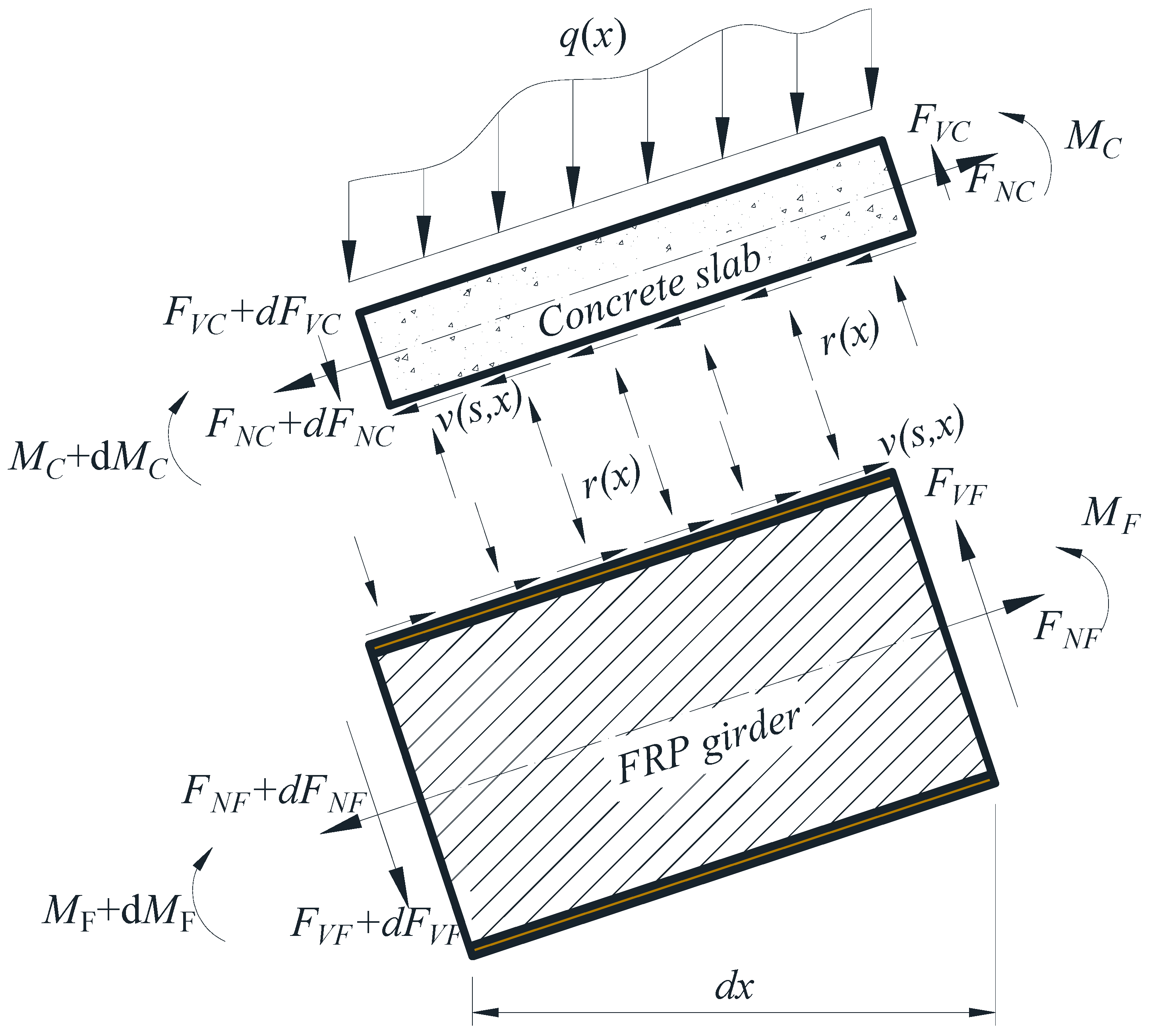

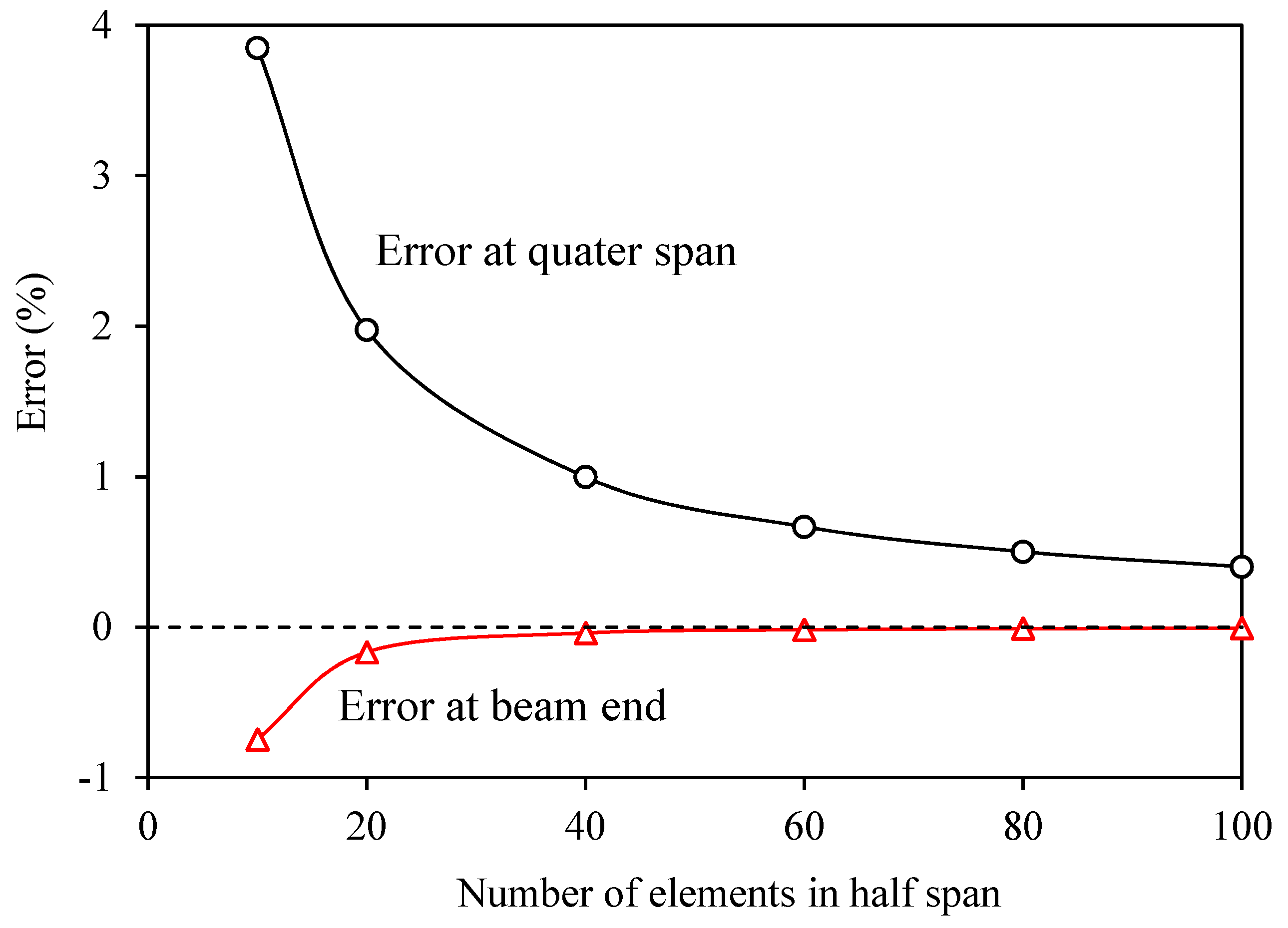
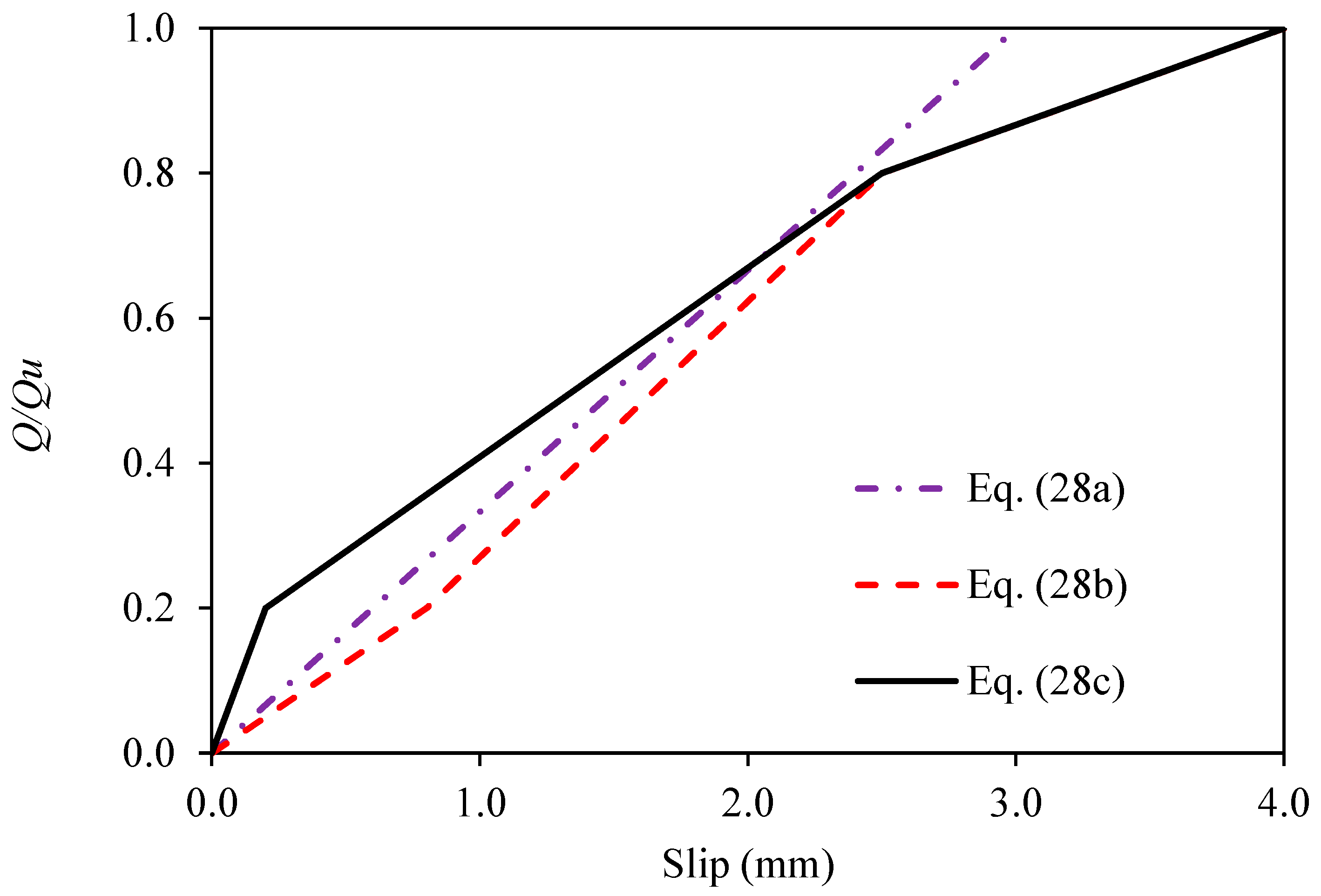
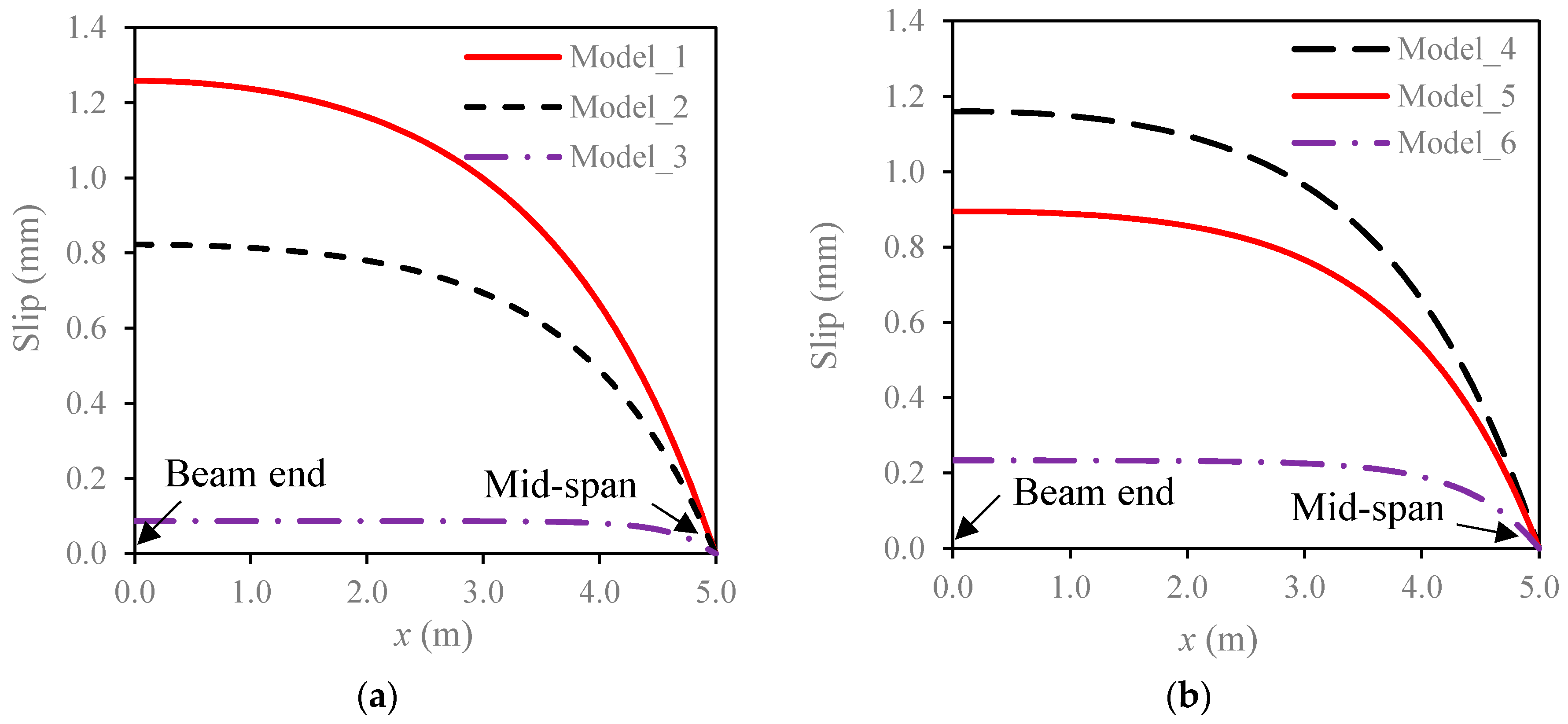
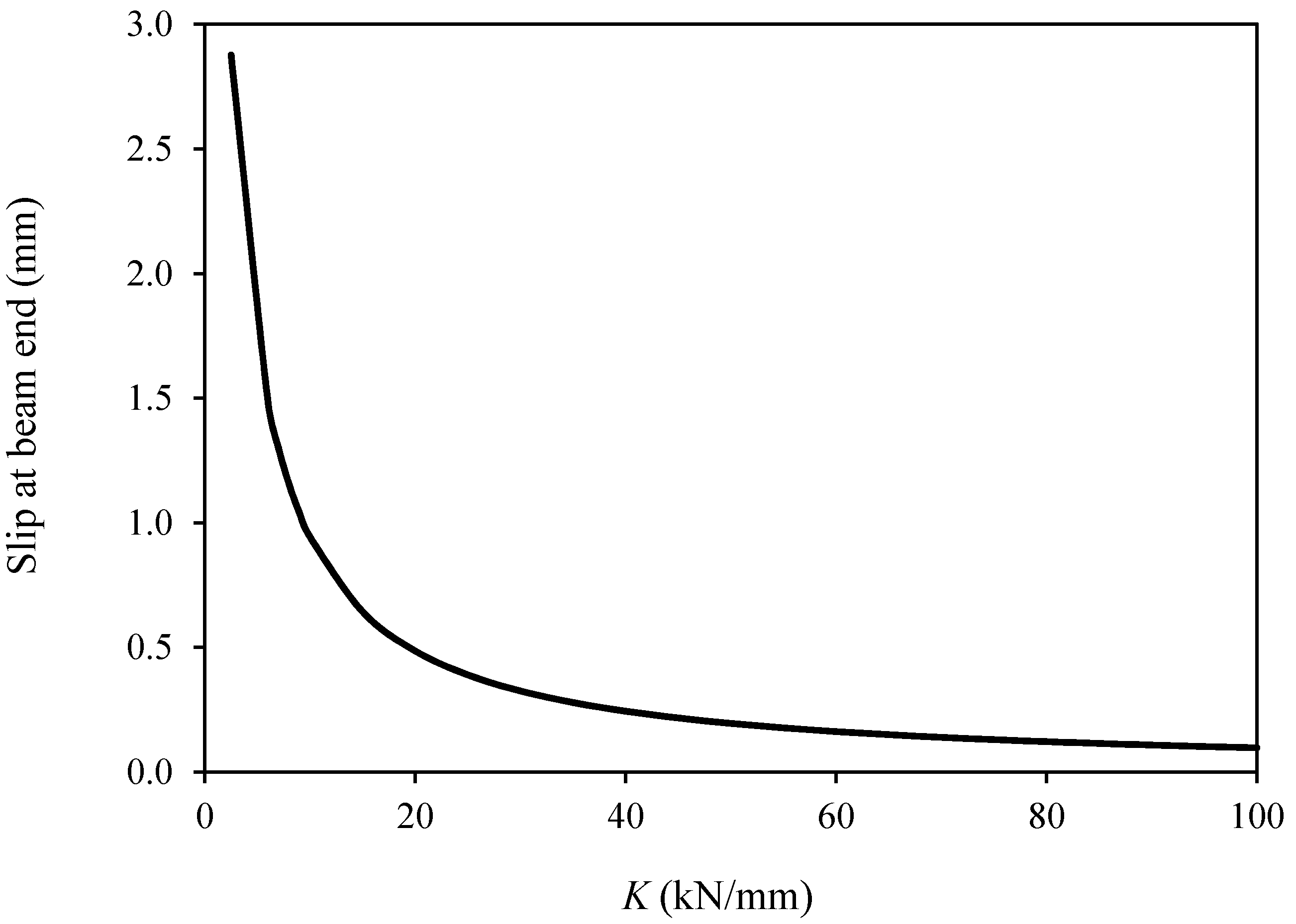
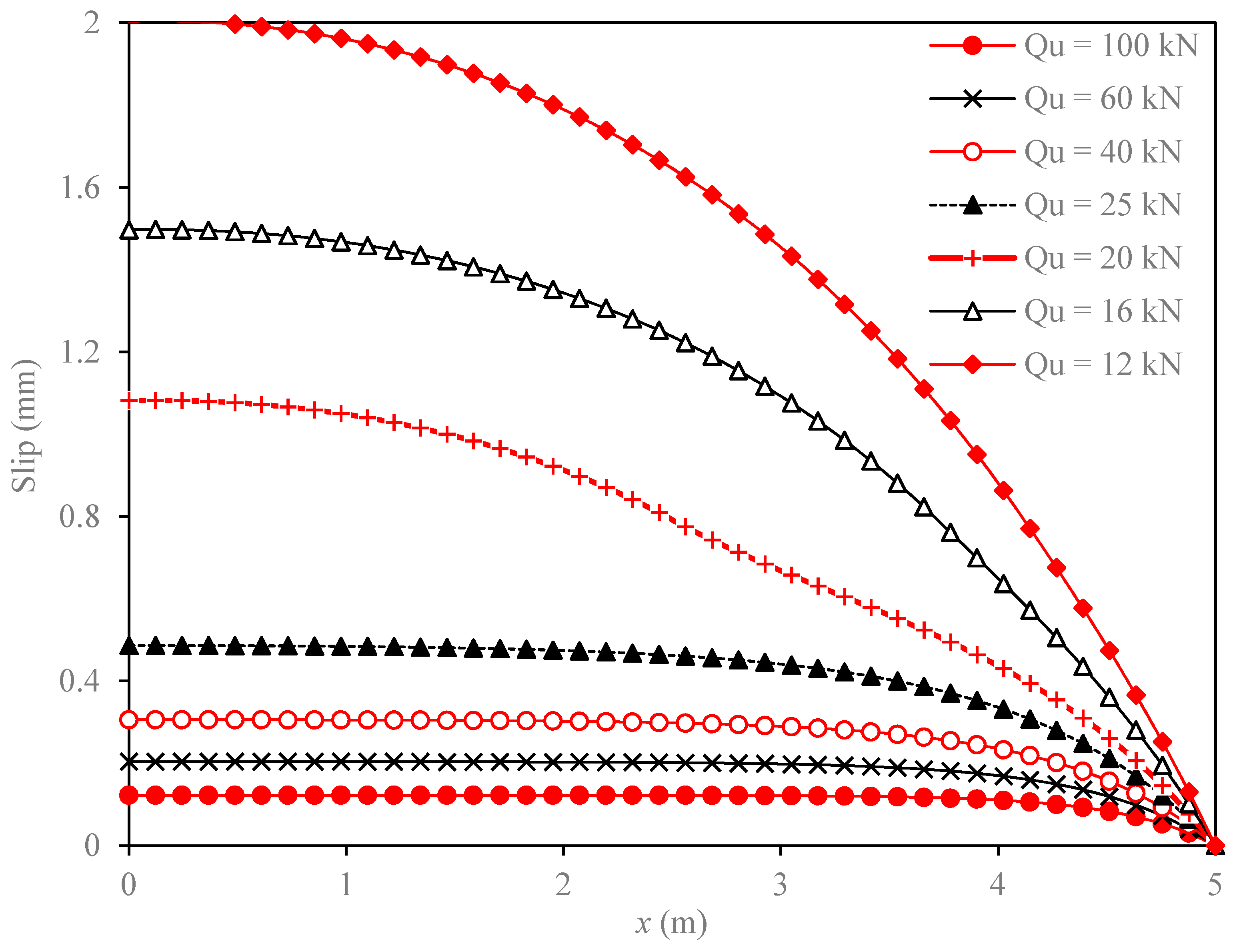
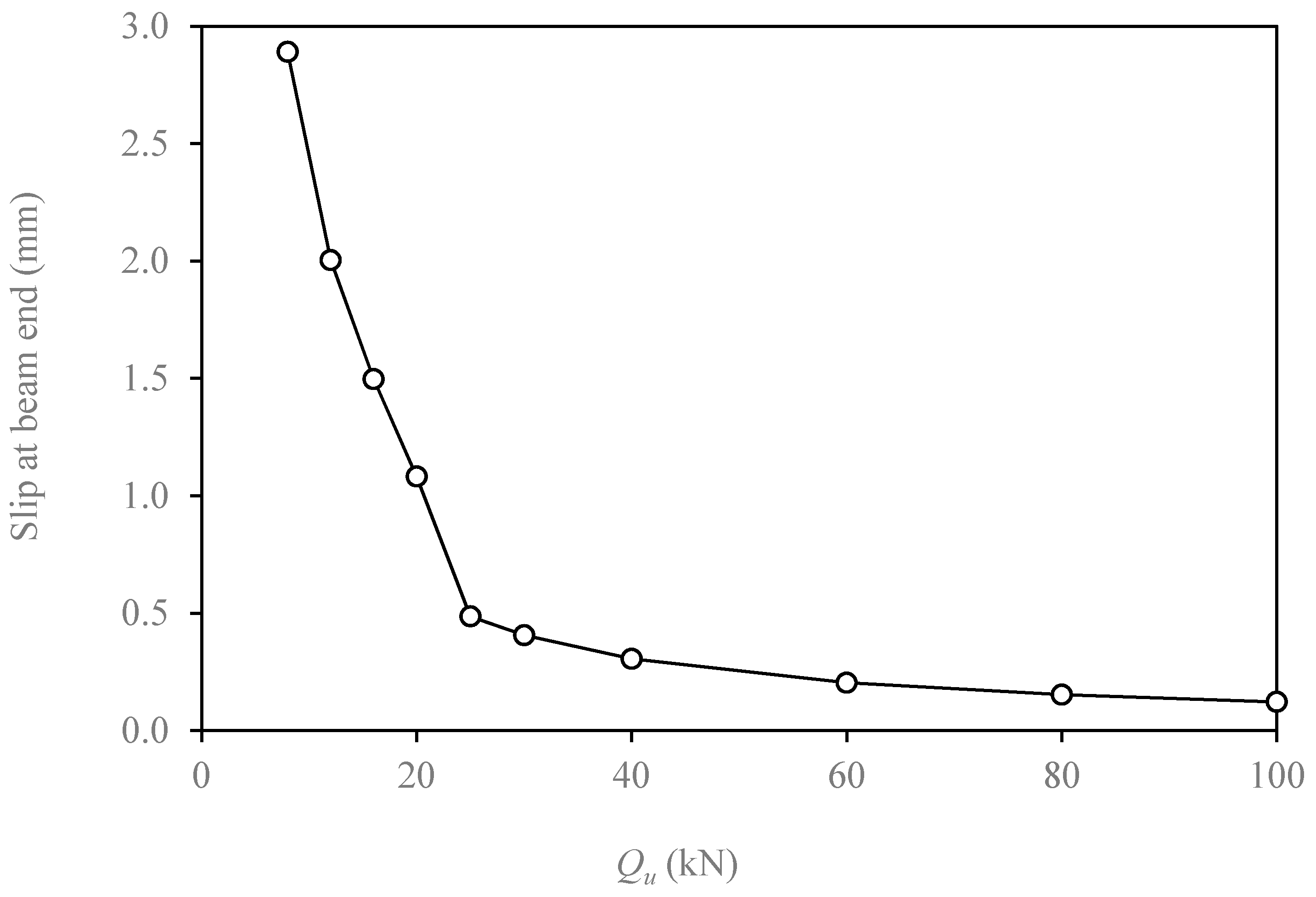

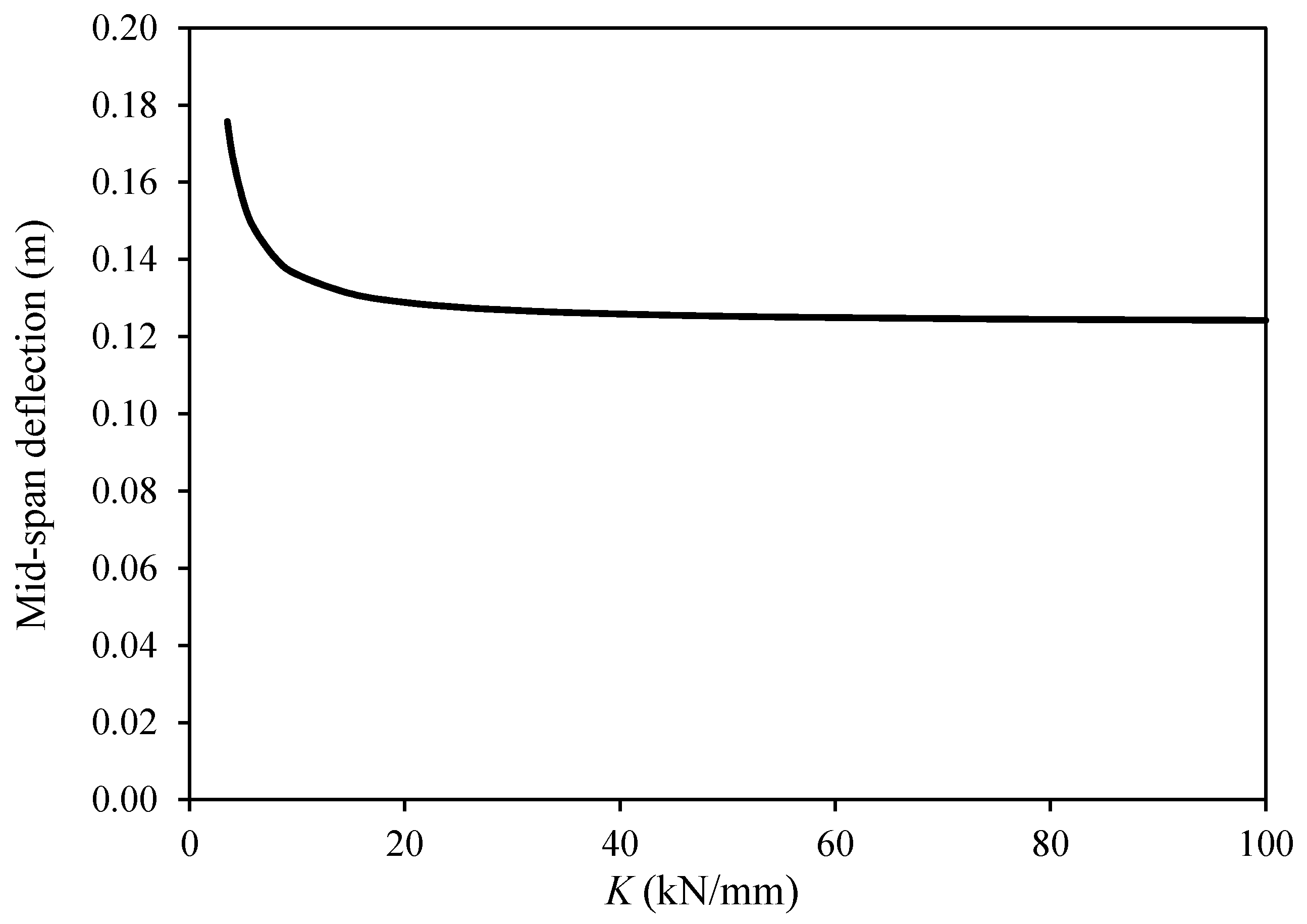
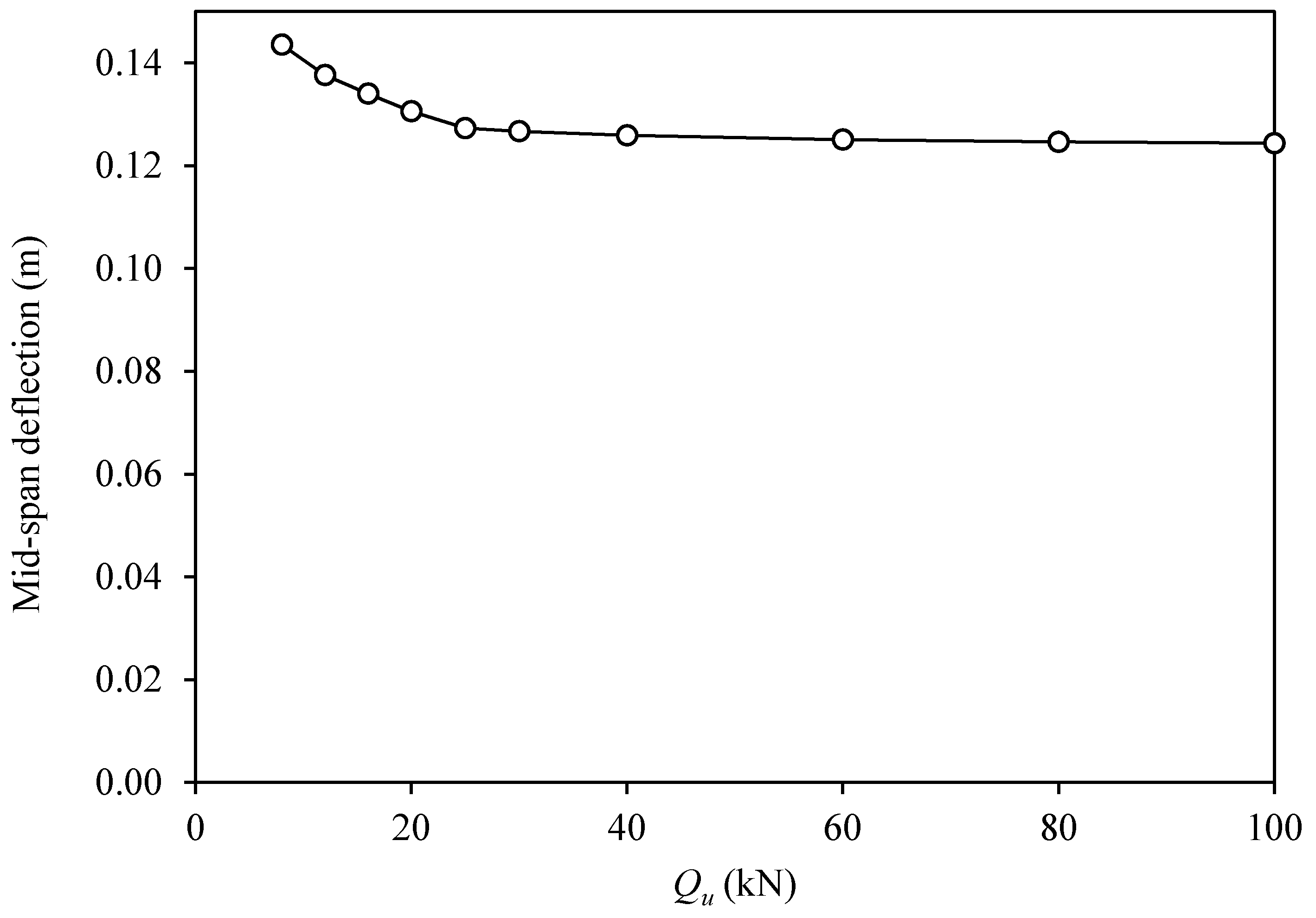
| Equation (27) | FDM | |||||||
|---|---|---|---|---|---|---|---|---|
| 10 | 20 | 40 | 60 | 80 | 100 | 1000 | ||
| Beam end slip (mm) | 1.4853 | 1.4742 | 1.4828 | 1.4847 | 1.4850 | 1.4851 | 1.4852 | 1.4853 |
| Quarter span slip (mm) | 1.2707 | 1.3197 | 1.2958 | 1.2834 | 1.2792 | 1.2771 | 1.2758 | 1.2713 |
| Error at beam end (%) | −0.745 | −0.166 | −0.039 | −0.017 | −0.010 | −0.006 | 0.000 | |
| Error at quarter span (%) | 3.850 | 1.975 | 0.998 | 0.667 | 0.501 | 0.401 | 0.040 | |
| Name | Model Type | Formula | Equation | Parameters |
|---|---|---|---|---|
| Model_1 | Linear | (28a) | 7.27 kN/mm | |
| Model_2 | Linear | 11.58 kN/mm | ||
| Model_3 | Linear | 112.67 kN/mm | ||
| Model_4 | Trilinear | (28b) | = 28.5 kN | |
| Model_5 | Trilinear | = 40.8 kN | ||
| Model_6 | Trilinear | (28c) | = 52.3 kN |
| Analysis | FDM | |||||||
|---|---|---|---|---|---|---|---|---|
| N = 10 | N = 20 | N = 40 | N = 60 | N = 80 | N = 100 | N = 1000 | ||
| (mm) | 0.13432 | 0.13462 | 0.13449 | 0.13441 | 0.13438 | 0.13437 | 0.13436 | 0.13433 |
| Error (%) | 0.225 | 0.128 | 0.067 | 0.046 | 0.034 | 0.028 | 0.003 | |
© 2018 by the authors. Licensee MDPI, Basel, Switzerland. This article is an open access article distributed under the terms and conditions of the Creative Commons Attribution (CC BY) license (http://creativecommons.org/licenses/by/4.0/).
Share and Cite
Gong, J.; Zou, X.; Shi, H.; Jiang, C.; Li, Z. Numerical Investigation of the Nonlinear Composite Action of FRP-Concrete Hybrid Beams/Decks. Appl. Sci. 2018, 8, 2031. https://doi.org/10.3390/app8112031
Gong J, Zou X, Shi H, Jiang C, Li Z. Numerical Investigation of the Nonlinear Composite Action of FRP-Concrete Hybrid Beams/Decks. Applied Sciences. 2018; 8(11):2031. https://doi.org/10.3390/app8112031
Chicago/Turabian StyleGong, Jianwu, Xingxing Zou, Han Shi, Cheng Jiang, and Zhaochao Li. 2018. "Numerical Investigation of the Nonlinear Composite Action of FRP-Concrete Hybrid Beams/Decks" Applied Sciences 8, no. 11: 2031. https://doi.org/10.3390/app8112031
APA StyleGong, J., Zou, X., Shi, H., Jiang, C., & Li, Z. (2018). Numerical Investigation of the Nonlinear Composite Action of FRP-Concrete Hybrid Beams/Decks. Applied Sciences, 8(11), 2031. https://doi.org/10.3390/app8112031







